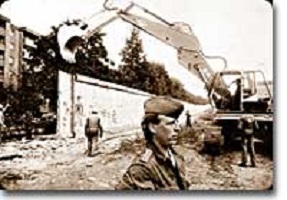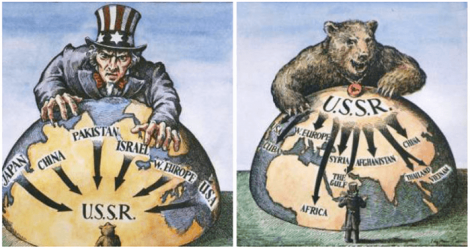What Theory Best Explains the End of the Cold War
It will then conclude that social constructivism is most convincing in explaining the Cold War. Writing in 1992 Fukuyama claimed that the end of the Cold War was the final victory for democracy and capitalism.

The End Of The Cold War Ushistory Org
Two of the best-known theories were developed by political scientists Samuel P.

. The Cold War was caused by the Soviet Union aggressively spreading CommunismSocialism. The removal of the metaphorical Iron Curtain meant that the citizens living in the West of the curtain now could have all information about the economic social and political conditions of the people living on the Eastern side of. And the end of the Cold War.
To many mutually assured destruction helped prevent the Cold War from turning hot. Although ideas belong to constructivist approach Gorbachevs desire and readiness to respect and promote human rights can also be explained by realist approach. The Non-Aligned Movement also had a note in the process that brought the Cold War finally to end.
HTML view is not available for this content. Morgenthau put forward the first comprehensive modern theory of inter- national relations-and the one from which most subsequent theories in that field have evolved-in his 1948 book Politics among Nations. The second theory holds economic pressures on the USSR due to competition with the USA culpable for the end of the Cold War.
Vietnam Egypt. IR theory after the Cold War GEORG S0RENSEN The end of the Cold War has prompted a good deal of soul-searching in the academic discipline of International Relations IR Some results of this process are already apparent. Huntington and Francis Fukuyama.
The end of the Cold War. However the focus will be on the one theory which is the most relevant in providing an explanation to the rationale behind the war. The third theory illustrated by realists analyses the contribution of internal factors leading to the collapse of the Soviet Union and the final theory illustrates the peace through strength thesis I believe that all the theories are strongly linked.
Second it will assess if neorealisms or social constructivisms core arguments can better explain three important dynamics of the Cold War namely bipolarity. Since the Enlightenment scholars have speculated that patterns of cooperation and conflict might be systematically related to the manner in which power is. The Domino Theory.
Without a revolutionary theory there can be no revolutionary movement. Yet Cold War thinking remains the guiding principle when approaching contemporary threats to state and international security alike Jacob 2017 xviii. The theory of hegemonic stability initially formulated by Kindleberger has been widely discussed and revised since this no longer explains the scenario that followed the Cold War.
The end of the Cold War and subsequent dissolution of the Soviet Union resulted in a new unipolar international system that presented fresh challenges to international relations theory. Wohlforth iNlodern realism began as a reaction to the breakdown of the post-World War I international order in the 1930s. The rapid conquest of French Indochina by the Japanese during the Second World War.
In retrospect the course of the Cold War appears to have been cyclical with both the United States and the USSR. United States will send aid to Cuba. Human rights ideas and the end of the Cold War One of the key ideas caused changes in Soviet domestic and foreign policy under Gorbachev is that of human rights.
Which statement BEST explains what these countries had in common during the late 20th century. However as you have access to this content a full PDF is available via the Save PDF action button. The collapse of great-power cooperation after World War II helped establish it as the dominant approach to the theory and practice of international politics in the United States.
These three theories are. The Struggle for Power and. The failure of French colonizers to apply their ideals in Indochina.
The dominant version of realism neorealism is developing in. The alliance behaviors of states. It is common knowledge that the Cold War primarily came to an end with the dissolution of the Union of Soviet Socialist Republics USSR.
The end of the struggle for Vietnamese independence known as the Indochina wars. The end of the Cold War has prompted a good deal of soul-searching in the academic discipline of International Relations IR. Alternating between periods of assertion and relaxation.
End of the Cold War William C. Some writers and academics have pondered what the Cold War means for the future. To others it is the most ludicrous theory humanity ever put into full-scale practice.
The evolution of the Cold War between the United States and the Soviet Union initiated a new US. Theory and the End of the Cold War 7 Hans J. The Cold War came to an end with the collapse of Communist parties rule in Eastern Europe and the Soviet Union and the disintegration of the Soviet Union.
In the first years after 1945 the United States hastily demobilized its wartime military forces while pursuing universal liberal internationalist solutions to problems of security and. Soviet Union will launch an invasion of the United States. United States will end the Cold War.
The domino theory was a Cold War policy that suggested a communist government in one nation would quickly lead to communist takeovers in neighboring states each falling like a perfectly aligned. State failures and the geopolitical disorder that followed were born out of policies generated by reified thinking as to what constitutes material threats in a world order transfigured by the end of the Cold War. The Soviet Union created the Cominform basically an organization that forced the countries in the Soviet Unions sphere of influence to adopt identical militarist cultural and economic policies in order to ensure Communism in these countries.
In 1945 English writer George Orwell first used the term cold war in a published. The dominant version of realism. Some results of this process are already apparent.
Its implications for the sustainability of American hegemony through hegemonic conception of control raw materials sources of financial capital flows and competitive advantages no longer applies to. The theory of realism can explain the Cold War if the Cold War itself is considered to be the end of an era of political and international relations theory the closing of a chapter if you will as the wave of new-found cooperation between post-war allies with the sole intention of pursuing mutually beneficial economic development embodied by the European Union. As the Cold War intensified the United States developed new foreign policies including the domino theory which became a foundation of American foreign policy.
The name and acronym of MAD come from physicist and polymath John von Neumann a key member of the Atomic Energy Commission and a man who helped the US develop nuclear devices.


Belum ada Komentar untuk "What Theory Best Explains the End of the Cold War"
Posting Komentar